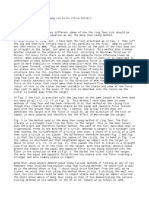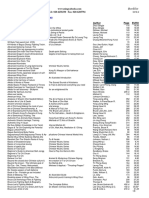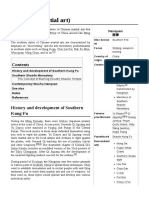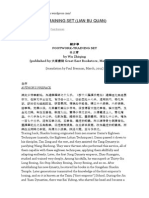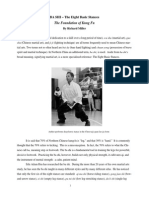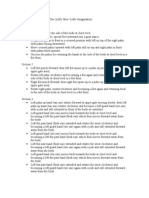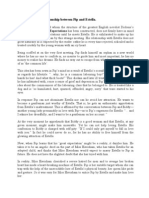Chi Sao
Chi Sao
Uploaded by
Anand SudamaCopyright:
Available Formats
Chi Sao
Chi Sao
Uploaded by
Anand SudamaCopyright
Available Formats
Share this document
Did you find this document useful?
Is this content inappropriate?
Copyright:
Available Formats
Chi Sao
Chi Sao
Uploaded by
Anand SudamaCopyright:
Available Formats
Wing Chun Kung Fu Page 1 of 1
Take Our Survey!
Tan Chi-Sao
web
Search:
angelfire
Ads by Google
One inch punch Wing chun kung fu ShowerTan Home Tanning
Using internal force of tai chi fa jing and push Secrets that the Martial Arts and Military Turn your shower into a spray tanning booth for
hands training Don't Want You To Know only $345.
www.classicaltaichi.com www.hikuta.net www.ShowerTan.com
Chi Sao
Contact Sensitivity Training
Wing Chun's Unique Method
By Si Fu Bob Shores student of Grandmaster William Cheung
Chi Sao is a specialized method of training which develops touch or contact reflexes and coordination of the limbs, while improving balance, close range focus of the eyes, and developing internal
energy for striking at close range. Chi Sao's side benefits include improvement of footwork for close range mobility, accuracy for striking and the ability to control an opponent's balance from the point of
contact. Although Chi Sao does not resemble fighting, the understanding of the application of force and technique gained through Chi Sao practice is invaluable and directly applicable to fighting.
A contact reflex is a conditioned response to a specific stimuli. Grandmaster Cheung often compares it to fishing. "You don't see the fish, but when it takes the bait you feel the vibration through
the line and rod". After a block, a point of contact is established. Through this point, any movement is transmitted as a vibration. The Wing Chun practitioner, through Chi Sao practice, can interpret this
vibration instantly, responding by simultaneously jamming the opponents intended move and counterattacking. This response is the same as the fisherman setting the hook. A contact reflex action.
There are three possible situations that can be detected at every contact point.
1. The incoming force will continue in the same direction.
2. The incoming force will stop before going on to another movement.
3. The incoming force will be withdrawn in the opposite or near opposite
direction.
Chi Sao is learned in three distinct stages. Each providing the Wing Chun student greater versatility, understanding and skill.
1. Single hand or Don Chi Sao parallel arm.
The basic drill begins with both practitioners facing each other square on. Practitioner "A", using a Tan Sao (palm up block), while practitioner "B" is using Fook Sao ( bridge on arm). The drill is
practiced on a three count.
1a. Practitioner "A" delivers a palm strike, and Practitioner "B" deflects the palm strike with Jut Sao (jerk hand block).
1b. Practitioner "B" delivers a straight punch to the head of Practitioner "A", as "A" defends with Bon Sao.
1c. Both practitioners return to the starting position
Each student takes turns in position A and B with each hand. Once the student reaches proficiency with the basic drill, there are other more advanced versions that are learned.
2. Single hand or Don Chi Sao cross arm.
This basic drill begins with both practitioners facing each other in front stances either right to right or left to left with the lead hands touching at, or near, the wrists in Wu Sao (guarding hand)
position.
2a. Practitioner "A" will apply Jut Sao to create an opening to punch at the head of Practitioner "B".
2b. As the punch is delivered, Practitioner "B" deflects the incoming blow with Tan Sao.
2c. Practitioner "A" presses the attack with another punch to the lower middle gate, while Practitioner "B" again deflects using Garn Sao.
2d. Practitioner "B" retaliates with a punch to the head of Practitioner"A", as Practitioner "A" deflects the blow with Tan Sao.
2e. Both practitioners return to the starting Wu Sao position.
As in the parallel arm drill each practitioner takes turns in position A and B with both sides. Again there are more advanced versions to be learned when proficiency has been developed in the basic
drill.
3. Double hand Chi Sao.
This is the most challenging of all the Chi Sao drills, and requires much greater focus and skill to perform. In double hand Chi Sao, the Wing Chun student learns to perform entirely different
movements simultaneously with each hand. The easiest way to accomplish this is by first learning the arm positions of the routine without a partner. Somewhat like a form. Then switching the
drill to the opposite sides, to develop ambidextrous ability. Once this is done, two practitioners can engage in Chi Sao practice. In this treatise, I will explain the positions as practiced by a single
individual. This type of practice is invaluable since probably 80% of the time, a practitioner will not have a partner to train with.
The basic routine is practiced on an eight count.
Starting position: The right hand is held in Tan Sao position directly under a left Fook Sao.
3a. The Fook Sao position is maintained as the right hand delivers a forward palm Wu Jeung.
3b. The Fook Sao position is maintained as the right hand returns to Tan Sao.
3c. The Fook Sao and Tan Sao are maintained. ( At This point a partner would return to Fook Sao)
3d. Fook Sao is lowered slightly as the Tan Sao rotates to Bon Sao position directly over the Fook Sao.
3e. The Bon Sao is maintained as the left hand performs Jut Sao.
3f. The Bon Sao is maintained as the left hand delivers a straight punch to the head.
3g. The Bon Sao is maintained as the left hand returns to Fook Sao position. ( Same as partner in 3c.)
3h. Fook Sao is maintained as Bon Sao rotates back to Tan Sao position. In each of the stages above, the Wing Chun student first learns predetermined drills or exercises and then advances to
random applications. Next, the student progresses to predetermined drills while blindfolded, and at last, to the most advanced stage of each exercise random while blindfolded.
The arm movement's for Chi Sao training are very precise in both position and application of force applied. These positions are learned in Shil Lim Tao form. Shil Lim Tao is prerequisite for Chi Sao
training. Without proper understanding of Shil Lim Tao correct Chi Sao is impossible!
Ads by Google
Basketball Defense Drills The Warrior Mook Jong A Step Ahead Prosthetics Power Factor Test Set
Effective Youth Basketball Drills & Modern dummies. Bruce Lee would Erik Schaffer, C.P Live Life Without Tangent Delta, Dissipation Factor
Practice Plans. Order Online Now! have loved them. From $599. Limitations! Frequency variable 12kV test set
www.CoachYouthBasketball.com thewarrior.com astepaheadonline.com www.omicron.at
http://www.angelfire.com/pa/99vs66/chisau.html 3/12/2009
You might also like
- Early On Kenpo HistoryDocument4 pagesEarly On Kenpo HistoryfagelnorhodhodNo ratings yet
- Case Tractor Cvx1135 To Cvx1195 Service ManualDocument24 pagesCase Tractor Cvx1135 To Cvx1195 Service Manualzolefiw98% (56)
- Shaolin 6 Close Strike The First Set Taught in The Northern Shaolin Style by Rick L WingDocument4 pagesShaolin 6 Close Strike The First Set Taught in The Northern Shaolin Style by Rick L Winggonzalo torres0% (1)
- National Wushu Standard Routines SeriesDocument2 pagesNational Wushu Standard Routines Seriescaliche66100% (1)
- #Soldier of Steel Training PlanDocument8 pages#Soldier of Steel Training PlanmajiNo ratings yet
- Chinese Martial Arts Shuai Jiao Association: Examining List of Ranking PromotionDocument23 pagesChinese Martial Arts Shuai Jiao Association: Examining List of Ranking PromotionDitirambi di DionisoNo ratings yet
- Ving Tsun Gung Fu The Science of in FightingDocument2 pagesVing Tsun Gung Fu The Science of in FightingGilcerto Alves100% (1)
- Chinese NumeralsDocument17 pagesChinese NumeralsHon MunNo ratings yet
- Siu Nim Tao ExplanationDocument10 pagesSiu Nim Tao Explanationjohn kantidesNo ratings yet
- WushuDocument12 pagesWushuArchie OrolloNo ratings yet
- The Joy of WushuDocument0 pagesThe Joy of Wushubaba2014No ratings yet
- Ving Tsun Kicking by Si-Fu Clive PotterDocument4 pagesVing Tsun Kicking by Si-Fu Clive PotterBagyi janosNo ratings yet
- WC DDJ Facebook PostDocument5 pagesWC DDJ Facebook PostPiyaporn WinthachaiNo ratings yet
- Chi Gong 101Document12 pagesChi Gong 101Joekapul100% (1)
- Wing ChunDocument15 pagesWing Chunnivra85No ratings yet
- History of East Asian Martial ArtsDocument7 pagesHistory of East Asian Martial ArtsZona Educación Especial ZacapaoaxtlaNo ratings yet
- Martial Arts Magazine Budo International 3671 - December 1 Fortnight - 2018Document347 pagesMartial Arts Magazine Budo International 3671 - December 1 Fortnight - 2018Herson RamirezNo ratings yet
- Kungfusports PDFDocument8 pagesKungfusports PDFfofofofoNo ratings yet
- To Work DummyDocument11 pagesTo Work DummyaldraNo ratings yet
- WingChun Sil Lum TaoDocument25 pagesWingChun Sil Lum TaoLuis Otavio O SantosNo ratings yet
- Buick Yip Dummies - Read MeDocument11 pagesBuick Yip Dummies - Read MeAndrew ChristenburyNo ratings yet
- Meibukan Magazine - 08Document38 pagesMeibukan Magazine - 08SebastiánNo ratings yet
- Jade Dragon Mo So White Sash Requirements-StudentDocument5 pagesJade Dragon Mo So White Sash Requirements-StudentTaizenziggyNo ratings yet
- Sifu Leung Ting Short BiographyDocument2 pagesSifu Leung Ting Short BiographyBabuKumarNo ratings yet
- A Perspective On Augustine Fong Wing ChunDocument11 pagesA Perspective On Augustine Fong Wing ChunBala Ratnakar KoneruNo ratings yet
- Chinese Kung Fu GongfuDocument36 pagesChinese Kung Fu GongfuIvette Carolina Tovar SegoviaNo ratings yet
- Chum Kiu Wingchun Second FormDocument3 pagesChum Kiu Wingchun Second FormHEJSANERTNo ratings yet
- Boxe Bafan Da Escola YueDocument69 pagesBoxe Bafan Da Escola YueandreaguirredoamaralNo ratings yet
- Leung Bik WCDocument2 pagesLeung Bik WCdimmo0% (1)
- Bruce Lee - Jeet Kune Do - OverviewDocument2 pagesBruce Lee - Jeet Kune Do - OverviewstNo ratings yet
- Nanquan (Martial Art)Document4 pagesNanquan (Martial Art)Simone WeillNo ratings yet
- Wing Chun Kung Fu - Elbow ForceDocument1 pageWing Chun Kung Fu - Elbow ForceVũ Đức Hà100% (1)
- 1tong Il Moo Do Manual Sbornik PDFDocument191 pages1tong Il Moo Do Manual Sbornik PDFСергей ФоминNo ratings yet
- Docsity Estudo Sobre Tecnicas Do Wing ChunDocument36 pagesDocsity Estudo Sobre Tecnicas Do Wing ChunCezar QueirozNo ratings yet
- Yee Jee Kim Yeung Ma - Goat Riding Stance of Wing Chun Kung FuDocument2 pagesYee Jee Kim Yeung Ma - Goat Riding Stance of Wing Chun Kung FuBagyi janos100% (2)
- Chen Taijiquan History - Por Qichen GuoDocument8 pagesChen Taijiquan History - Por Qichen GuoCarvalhoNo ratings yet
- Martial Arts 1 CombinedDocument54 pagesMartial Arts 1 Combinedleanielpayos911No ratings yet
- Forma Lian Bu QuanDocument73 pagesForma Lian Bu QuanandreaguirredoamaralNo ratings yet
- Fact SheetDocument1 pageFact Sheetdiamond68No ratings yet
- Mastering: Mamma Mia! Nippon NibblesDocument4 pagesMastering: Mamma Mia! Nippon NibblesDKNo ratings yet
- Bruce Lee's Kicking WorkoutsDocument2 pagesBruce Lee's Kicking WorkoutsbabagazeboNo ratings yet
- Pentjak-Silat - The Indonesian Fighting Art Martial Arts Self Defense (PDFDrive)Document72 pagesPentjak-Silat - The Indonesian Fighting Art Martial Arts Self Defense (PDFDrive)aia1954100% (1)
- BA SHI - The Eight Basic Stances: The Foundation of Kung FuDocument8 pagesBA SHI - The Eight Basic Stances: The Foundation of Kung FujordannobleNo ratings yet
- Top 10 Fighting StylesDocument12 pagesTop 10 Fighting StylesAnimesh Ghosh100% (1)
- A Tale of Yuen Kay SanDocument2 pagesA Tale of Yuen Kay SanShadow_Warrior88100% (2)
- Course Information Course Name: Physical Fitness & ConditioningDocument5 pagesCourse Information Course Name: Physical Fitness & ConditioningYabsNo ratings yet
- Xingyi FistDocument20 pagesXingyi FistRUSLAN100% (1)
- Fighting WC KFDocument0 pagesFighting WC KFFrank TursackNo ratings yet
- New Translation The Study of Bagua Quan by Sun LutangDocument9 pagesNew Translation The Study of Bagua Quan by Sun LutangQiGongExerciseNo ratings yet
- Bagua Aarvo Luigi PDFDocument6 pagesBagua Aarvo Luigi PDFwakasensei99No ratings yet
- Understanding The Red Boats of The Cantonese OperaDocument5 pagesUnderstanding The Red Boats of The Cantonese OperaYuliya GingikovnaNo ratings yet
- Siu Lim Tao / Siu Nim Tao (Little Idea)Document3 pagesSiu Lim Tao / Siu Nim Tao (Little Idea)biboy70No ratings yet
- 插捶Document56 pages插捶Juan Ignacio RizzaNo ratings yet
- Winhchun StanceDocument6 pagesWinhchun StancenambaccucNo ratings yet
- Wing Chun Terms: From Wikipedia, The Free EncyclopediaDocument3 pagesWing Chun Terms: From Wikipedia, The Free EncyclopediarazonemcNo ratings yet
- Journal of The College of Chinese Martial Arts 1Document20 pagesJournal of The College of Chinese Martial Arts 1Anonymous S3x7YTUO100% (2)
- Iron Legends: The Training and Diet Principles of Vince Gironda and Charles GlassFrom EverandIron Legends: The Training and Diet Principles of Vince Gironda and Charles GlassNo ratings yet
- 8 Ways to Benefit from Critique and Testing in the Martial Arts: The Power Trip: How to Survive and Thrive in the Dojo, #5From Everand8 Ways to Benefit from Critique and Testing in the Martial Arts: The Power Trip: How to Survive and Thrive in the Dojo, #5No ratings yet
- DISA Module 5Document13 pagesDISA Module 5Jai Prakash AgarwalNo ratings yet
- The Story of JosephDocument21 pagesThe Story of JosephKarlaNo ratings yet
- WAPO1Q11Document7 pagesWAPO1Q11Inde Pendent LkNo ratings yet
- Development of Relationship Between Pip & EstellaDocument2 pagesDevelopment of Relationship Between Pip & EstellaMiah Rashiduzzaman79% (14)
- 3-5 - Thailand - 20080526 - Thailand Single Window E-Logistics - Seoul v2.0Document38 pages3-5 - Thailand - 20080526 - Thailand Single Window E-Logistics - Seoul v2.0glassyglassNo ratings yet
- Submis 2Document14 pagesSubmis 2Cao Chen-RuiNo ratings yet
- Critical TasksDocument8 pagesCritical TasksTina ManuelNo ratings yet
- 6T30 6T40Document8 pages6T30 6T40Fabiano Silva AzechiNo ratings yet
- Lubricacion Por Niebla CatalogoDocument68 pagesLubricacion Por Niebla Catalogocallisr100% (1)
- Infant and Toddler Concussion Guide: Signs & SymptomsDocument2 pagesInfant and Toddler Concussion Guide: Signs & Symptomspeninah annNo ratings yet
- Transport Cost& Modes of TransportationDocument5 pagesTransport Cost& Modes of TransportationFareen S FareenNo ratings yet
- Office of The Family and Children'S OmbudsDocument79 pagesOffice of The Family and Children'S OmbudsKING 5 NewsNo ratings yet
- Learning Episode 11Document6 pagesLearning Episode 11John Rolan SallanNo ratings yet
- Folic AcidDocument5 pagesFolic Acidjyoti singhNo ratings yet
- Chapters 1-2 Exercises SetDocument6 pagesChapters 1-2 Exercises SetsonihdlgNo ratings yet
- Zoom G2.1u English ManualDocument25 pagesZoom G2.1u English ManualKevin KerberNo ratings yet
- Kuliah Simmel 10 DecDocument26 pagesKuliah Simmel 10 DecMuhammad Fiel KautsarNo ratings yet
- SAP Inventory Movement TypeDocument15 pagesSAP Inventory Movement TypeRaul KarkyNo ratings yet
- Bop Ram ChangeDocument2 pagesBop Ram ChangeAbdul Hameed OmarNo ratings yet
- HemeDocument9 pagesHemeCadenzaNo ratings yet
- B40D Electrical MKLLLDocument46 pagesB40D Electrical MKLLLdwayneharveyNo ratings yet
- PRC Forms AdzuDocument14 pagesPRC Forms AdzushaneequaNo ratings yet
- Chapter 4: AC Circuits: 2076 Set B Q.No.1 2070 Set C Q.No.1 220 V A.C. Is More Dangor Than 220 V D.C., Why?Document21 pagesChapter 4: AC Circuits: 2076 Set B Q.No.1 2070 Set C Q.No.1 220 V A.C. Is More Dangor Than 220 V D.C., Why?Suraj Bhandari100% (1)
- Examples of Definition EssaysDocument3 pagesExamples of Definition Essaysafibxprddfwfvp100% (2)
- LABDCT 2001 (Guide) Nexus.7000Document44 pagesLABDCT 2001 (Guide) Nexus.7000kds20850No ratings yet
- RFP Caste Based Survey BSEDCDocument138 pagesRFP Caste Based Survey BSEDCসাম্য মুখার্জীNo ratings yet
- Math Demo Dec 2 2019 PrintDocument16 pagesMath Demo Dec 2 2019 PrintHazy Jade Hombrog RugaNo ratings yet
- Budhwar (Wednesday) Vrat Katha (Story)Document1 pageBudhwar (Wednesday) Vrat Katha (Story)Anandh ShankarNo ratings yet
- Pre-Shipment Analysis ReportDocument1 pagePre-Shipment Analysis ReportAsdaRrNo ratings yet











